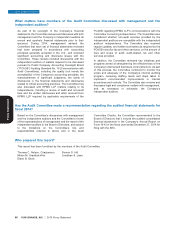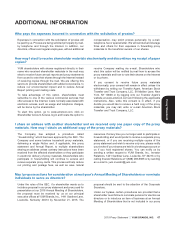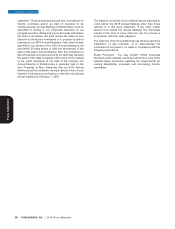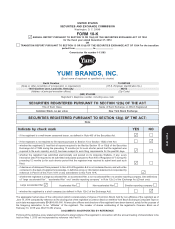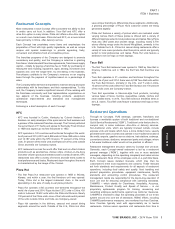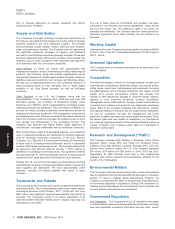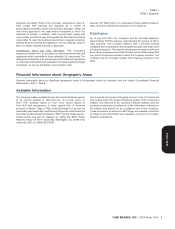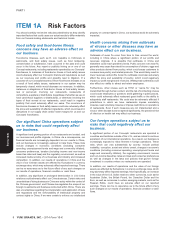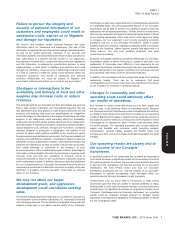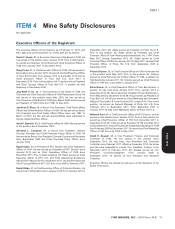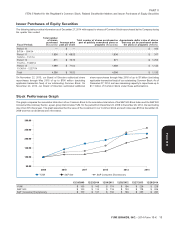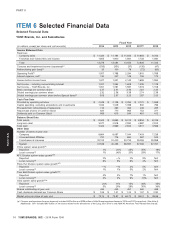Pizza Hut 2014 Annual Report Download - page 98
Download and view the complete annual report
Please find page 98 of the 2014 Pizza Hut annual report below. You can navigate through the pages in the report by either clicking on the pages listed below, or by using the keyword search tool below to find specific information within the annual report.
13MAR201517272138
PART I
ITEM 1 Business
time to promote adherence to system standards and mentor The use of these marks by franchisees and licensees has been
restaurant team members. authorized in our franchise and license agreements. Under current
law and with proper use, the Company’s rights in its marks can
generally last indefinitely. The Company also has certain patents on
Supply and Distribution restaurant equipment which, while valuable, are not material to its
business.
The Company’s Concepts, including Concept units operated by its
franchisees, are substantial purchasers of a number of food and paper
products, equipment and other restaurant supplies. The principal Working Capital
items purchased include chicken, cheese, beef and pork products,
paper and packaging materials. The Company has not experienced Information about the Company’s working capital is included in MD&A
any significant continuous shortages of supplies, and alternative in Part II, Item 7 and the Consolidated Statements of Cash Flows in
sources for most of these products are generally available. Prices paid Part II, Item 8.
for these supplies fluctuate. When prices increase, the Concepts may
attempt to pass on such increases to their customers, although there Seasonal Operations
is no assurance that this can be done practically.
The Company does not consider its operations to be seasonal to any
China Division. In China, we partner with approximately 600 material degree.
independent suppliers, mostly China-based, providing a wide range of
products. The Company, along with multiple independently owned
and operated distributors, utilizes approximately 20 logistic centers to Competition
distribute restaurant products to our Company and franchise stores.
The retail food industry, in which our Concepts compete, is made up of
We also own a seasoning facility and a non-controlling interest in a
supermarkets, supercenters, warehouse stores, convenience stores,
meat processing facility in Inner Mongolia, both of which supply
coffee shops, snack bars, delicatessens and restaurants (including
products to our Little Sheep business, as well as third-party
the QSR segment), and is intensely competitive with respect to food
customers.
quality, price, service, convenience, location and concept. The
Other Divisions. In the U.S., the Company, along with the industry is often affected by changes in consumer tastes; national,
representatives of the Company’s KFC, Pizza Hut and Taco Bell regional or local economic conditions; currency fluctuations;
franchisee groups, are members of Restaurant Supply Chain demographic trends; traffic patterns; the type, number and location of
Solutions, LLC (‘‘RSCS’’), which is responsible for purchasing certain competing food retailers and products; and disposable purchasing
restaurant products and equipment. The core mission of RSCS is to power. Each of the Concepts competes with international, national
provide the lowest possible sustainable store-delivered prices for and regional restaurant chains as well as locally-owned restaurants,
restaurant products and equipment. This arrangement combines the not only for customers, but also for management and hourly
purchasing power of the Company-owned and franchisee restaurants personnel, suitable real estate sites and qualified franchisees. Given
which the Company believes leverages the system’s scale to drive the various types and vast number of competitors, our Concepts do
cost savings and effectiveness in the purchasing function. The not constitute a significant portion of the retail food industry in terms of
Company also believes that RSCS fosters closer alignment of number of system units or system sales, either on a worldwide or
interests and a stronger relationship with its franchisee community. individual country basis.
Most food products, paper and packaging supplies, and equipment
used in restaurant operations are distributed to individual restaurant Research and Development (‘‘R&D’’)
units by third-party distribution companies. In the U.S., McLane
The Company operates R&D facilities in Shanghai, China (China
Company, Inc. (‘‘McLane’’) is the exclusive distributor for the majority
Division); Plano, Texas (KFC and Pizza Hut Divisions); Irvine,
of items used in Company-owned restaurants and for a substantial
California (Taco Bell Division); Louisville, Kentucky (KFC U.S.) and
number of franchisee and licensee stores. The Company entered into
several other locations outside the U.S. The Company expensed
an agreement with McLane effective January 1, 2011 relating to
$30 million, $31 million and $30 million in 2014, 2013 and 2012,
distribution to Company-owned restaurants. This agreement extends
respectively, for R&D activities. From time to time, independent
through December 31, 2016 and generally restricts Company-owned
suppliers also conduct research and development activities for the
restaurants from using alternative distributors for most products.
benefit of the YUM system.
Outside the U.S., we and our franchisees use decentralized sourcing
and distribution systems involving many different global, regional and
local suppliers and distributors. We have approximately 3,000 Environmental Matters
suppliers, including U.S.-based suppliers that export to many The Company is not aware of any federal, state or local environmental
countries. laws or regulations that will materially affect its earnings or competitive
position, or result in material capital expenditures. However, the
Company cannot predict the effect on its operations of possible future
Trademarks and Patents environmental legislation or regulations. During 2014, there were no
The Company and its Concepts own numerous registered trademarks material capital expenditures for environmental control facilities and
and service marks. The Company believes that many of these marks, no such material expenditures are anticipated.
including its Kentucky Fried Chicken姞, KFC姞, Pizza Hut姞 and Taco
Bell姞 marks, have significant value and are materially important to its
business. The Company’s policy is to pursue registration of its Government Regulation
important marks whenever feasible and to oppose vigorously any U.S. Operations. The Company and its U.S. operations are subject
infringement of its marks. to various federal, state and local laws affecting its business, including
laws and regulations concerning information security, labor, health,
4YUM! BRANDS, INC. - 2014 Form 10-K
Form 10-K


